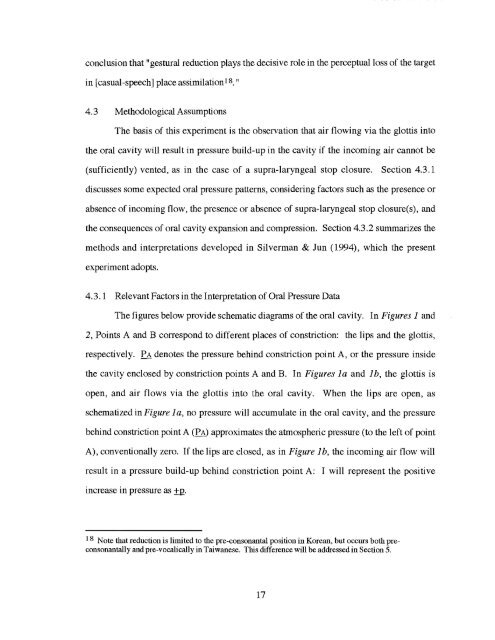A Phonetically-Based Optimality Theoretic Account of Consonant ...
A Phonetically-Based Optimality Theoretic Account of Consonant ...
A Phonetically-Based Optimality Theoretic Account of Consonant ...
Create successful ePaper yourself
Turn your PDF publications into a flip-book with our unique Google optimized e-Paper software.
conclusion that" gestural reduction plays the decisive role in the perceptual loss <strong>of</strong> the target<br />
in [casual-speech] place assimilation l8 . "<br />
4.3 Methodological Assumptions<br />
The basis <strong>of</strong> this experiment is the observation that air flowing via the glottis into<br />
the oral cavity will result in pressure build-up in the cavity if the incoming air cannot be<br />
(sufficiently) vented, as in the case <strong>of</strong> a supra-laryngeal stop closure. Section 4.3.1<br />
discusses some expected oral pressure patterns, considering factors such as the presence or<br />
absence <strong>of</strong> incoming flow, the presence or absence <strong>of</strong> supra-laryngeal stop closure(s), and<br />
the consequences <strong>of</strong> oral cavity expansion and compression. Section 4.3.2 summarizes the<br />
methods and interpretations developed in Silverman & Jun (1994), which the present<br />
experiment adopts.<br />
4.3. 1 Relevant Factors in the Interpretation <strong>of</strong> Oral Pressure Data<br />
The figures below provide schematic diagrams <strong>of</strong> the oral cavity. In Figures land<br />
2, Points A and B correspond to different places <strong>of</strong> constriction: the lips and the glottis,<br />
respectively. PA denotes the pressure behind constriction point A, or the pressure inside<br />
the cavity enclosed by constriction points A and B. In Figures 1 a and 1 b, the glottis is<br />
open, and air flows via the glottis into the oral cavity. When the lips are open, as<br />
schematizedinFigure la, no pressure will accumulate in the oral cavity, and the pressure<br />
behind constriction point A (W approximates the atmospheric pressure (to the left <strong>of</strong> point<br />
A), conventionally zero. If the lips are closed, as in Figure 1 b, the incoming air flow will<br />
result in a pressure build-up behind constriction point A: I will represent the positive<br />
increase in pressure as ±p..<br />
18 Note that reduction is limited to the pre-consonantal position in Korean, but occurs both preconsonantally<br />
and pre-vocalically in Taiwanese. This difference will be addressed in Section 5.<br />
17
















